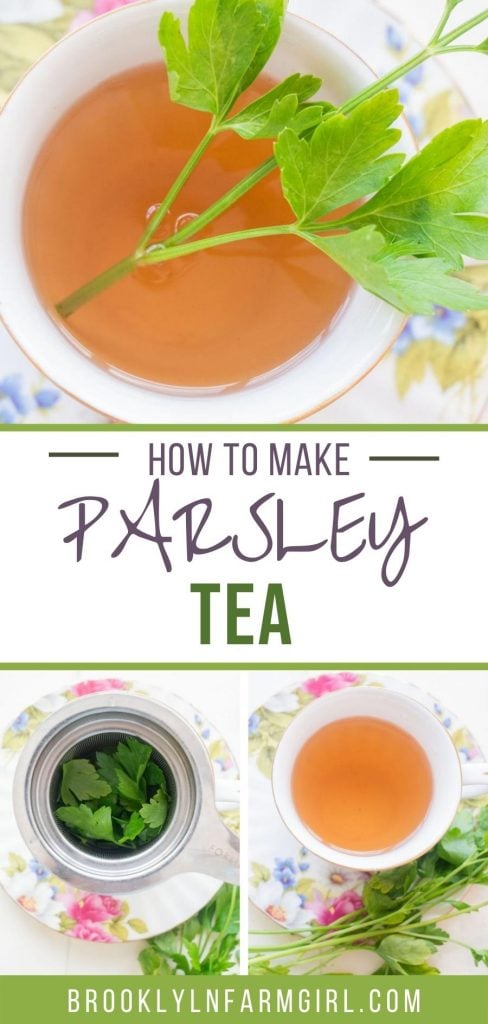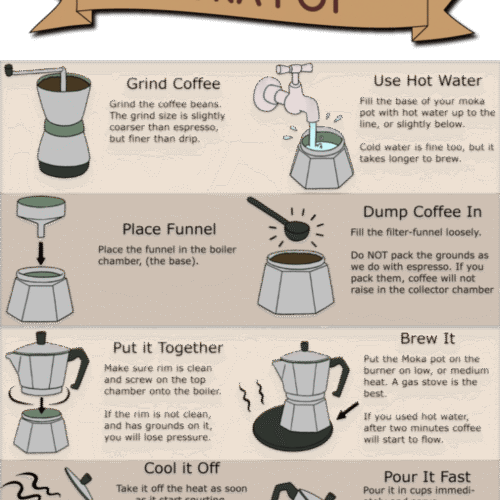To make parsley tea, steep fresh or dried parsley in hot water for about 5-10 minutes. Strain and enjoy.
Parsley tea is a refreshing herbal beverage known for its numerous health benefits. Rich in vitamins and antioxidants, it aids digestion and supports kidney health. Making parsley tea at home is simple and requires minimal ingredients. Fresh parsley is typically preferred for its vibrant flavor, but dried parsley works well too.
This tea not only offers a pleasant taste but also serves as a natural diuretic. Drinking parsley tea regularly can help detoxify the body and improve overall well-being. Enjoy it hot or cold, and consider adding a slice of lemon for an extra zest.

Credit: www.wikihow.com
Introduction To Parsley Tea
Parsley tea is a simple and delightful herbal drink. It is made by infusing parsley leaves in hot water. This tea offers numerous health benefits and is easy to prepare at home. Whether you are a tea enthusiast or a health-conscious individual, parsley tea is worth trying.
What Is Parsley Tea?
Parsley tea is a refreshing beverage made from fresh or dried parsley leaves. This tea is known for its unique flavor and potential health benefits. Parsley, a common kitchen herb, is rich in vitamins and antioxidants. Drinking parsley tea can be a soothing and beneficial daily ritual.
Historical Uses
Parsley has been used for centuries in various cultures. In ancient Greece and Rome, parsley was used for medicinal purposes. It was believed to aid digestion and relieve bloating. In traditional medicine, parsley was also used to treat kidney stones and urinary tract infections.
In some cultures, parsley tea was consumed to promote menstrual health. It was thought to help regulate menstrual cycles and alleviate cramps. Over the years, parsley tea has remained a popular natural remedy.
Health Benefits
Parsley tea is not just a soothing drink. It’s packed with health benefits. From detoxification to rich nutritional content, parsley tea offers a lot.
Detoxification Properties
Parsley tea aids in detoxifying the body. It helps to flush out toxins. This promotes better kidney function. The diuretic properties of parsley help remove excess fluids. This is essential for reducing bloating and water retention.
It also helps in cleansing the liver. A healthy liver means a healthier you. Drinking parsley tea regularly can support your body’s natural detox processes. This makes you feel more energetic and vibrant.
Nutritional Content
Parsley is rich in vitamins and minerals. A cup of parsley tea provides:
- Vitamins A, C, and K
- Folate
- Iron
- Calcium
- Potassium
Vitamin A boosts eye health. Vitamin C strengthens the immune system. Vitamin K supports bone health. Folate is important for cell growth. Iron helps in blood formation. Calcium supports strong bones and teeth. Potassium balances body fluids.
All these nutrients make parsley tea a powerful drink. It supports overall health and well-being.
Choosing The Right Parsley
Choosing the right parsley is crucial for making delicious parsley tea. The quality and type of parsley you use can greatly affect the flavor and health benefits of your tea. Let’s explore the different options available to ensure you make the best choice.
Fresh Vs. Dried
Fresh parsley has a vibrant flavor and more nutrients. It’s the preferred choice for many tea enthusiasts. Fresh parsley leaves should be bright green and free from yellow spots.
Dried parsley is a convenient alternative. It has a longer shelf life and is easier to store. While it might not have the same intense flavor as fresh, it still makes a tasty tea. Dried parsley is often more concentrated, so you might need less of it.
| Type | Flavor | Shelf Life |
|---|---|---|
| Fresh Parsley | Vibrant | Short |
| Dried Parsley | Milder | Long |
Organic Options
Organic parsley is grown without harmful pesticides and chemicals. This makes it a healthier choice for tea. Organic herbs often have a richer flavor due to natural growing methods.
Look for organic certification on the packaging to ensure quality. Local farmers’ markets are great places to find fresh, organic parsley. Organic options are not only better for your health but also for the environment.
- Healthier choice
- Richer flavor
- Environmentally friendly
Whether you choose fresh or dried, organic parsley will enhance your tea experience.

Credit: brooklynfarmgirl.com
Ingredients Needed
Making parsley tea requires a few simple ingredients. These ingredients are easy to find. You can create a refreshing tea with these items. Below is a list of the essential and optional ingredients needed.
Essential Ingredients
- Fresh Parsley: Use about 1/4 cup of fresh parsley.
- Water: Boil 2 cups of water.
- Lemon Juice: Add a few drops for taste.
- Honey: Use a teaspoon to sweeten the tea.
Optional Additions
You can add more flavors to your parsley tea. Here are some ideas:
- Ginger: Add a small slice for a spicy kick.
- Mint Leaves: Use a few leaves for a fresh taste.
- Cinnamon Stick: Add one stick for a warm flavor.
- Apple Slices: Add a few slices for sweetness.
These optional ingredients can enhance your tea’s flavor. Experiment with different additions to find your favorite blend.
| Ingredient | Quantity | Purpose |
|---|---|---|
| Fresh Parsley | 1/4 cup | Main ingredient |
| Water | 2 cups | Base for the tea |
| Lemon Juice | A few drops | Adds a tangy flavor |
| Honey | 1 teaspoon | Sweetens the tea |
Step-by-step Preparation
Making parsley tea at home is simple and rewarding. Follow these steps for a refreshing cup of this herbal drink. Let’s dive into the detailed process.
Preparing The Parsley
Before brewing, you need to prepare the parsley properly. Follow these steps:
- Gather fresh parsley: Choose fresh, green parsley for the best flavor.
- Wash the parsley: Rinse under cold water to remove dirt.
- Chop the parsley: Finely chop about 1/4 cup of parsley leaves.
Brewing The Tea
Now, let’s move on to brewing the tea. Follow these easy steps:
- Boil water: Bring 2 cups of water to a boil.
- Add parsley: Place chopped parsley into a teapot or mug.
- Pour water: Pour boiling water over the parsley.
- Steep: Let it steep for about 5-10 minutes.
- Strain: Use a strainer to remove the parsley leaves.
- Serve: Pour into a cup and enjoy your tea.
For added flavor, you can include a slice of lemon or a bit of honey. Enjoy your homemade parsley tea!

Credit: m.youtube.com
Flavor Enhancements
Enhancing the flavor of parsley tea can make it more enjoyable. You can add various ingredients to boost its taste. Below are some popular options for flavor enhancements.
Adding Citrus
Adding citrus fruits can bring a fresh twist to your parsley tea. Citrus fruits like lemon, lime, or orange are great choices. They add a zesty flavor that complements the parsley.
- Lemon: Squeeze half a lemon into your tea.
- Lime: Use lime juice for a tangy kick.
- Orange: Add a few slices of orange for sweetness.
Sweetening Options
Parsley tea can be a bit bitter. Adding a sweetener can balance the taste. You have several options for sweetening your tea.
| Sweetener | Benefits |
|---|---|
| Honey | Natural and adds a rich flavor. |
| Agave Syrup | Low glycemic index, good for diabetics. |
| Stevia | Zero calories, great for weight watchers. |
Choose a sweetener that matches your dietary needs. Adding these can make your parsley tea delightful.
Serving Suggestions
Parsley tea is a versatile drink that can be enjoyed in many ways. Whether you prefer it hot or cold, or with a hint of garnish, there’s a perfect serving suggestion for you. Let’s explore some delightful ways to serve parsley tea.
Hot Vs. Cold
Hot Parsley Tea: This is a great option for chilly days. To prepare, simply pour hot water over fresh or dried parsley and let it steep for 5-10 minutes. Serve it in your favorite mug and enjoy the comforting warmth.
Cold Parsley Tea: Ideal for warm weather, cold parsley tea is refreshing and revitalizing. Brew the tea as you would for hot tea, then let it cool down. Add ice cubes and a slice of lemon for extra zest.
Garnishing Ideas
| Garnish | Flavor Profile |
|---|---|
| Lemon Slices | Citrusy and fresh |
| Mint Leaves | Cooling and aromatic |
| Honey | Sweet and soothing |
| Ginger Slices | Spicy and warming |
Use these garnishes to enhance the flavor of your parsley tea. Each garnish brings a unique twist, making your tea experience exciting and delicious.
Potential Side Effects
Parsley tea offers many health benefits. But, it’s important to know the potential side effects. Not everyone should drink parsley tea. Let’s explore who should avoid it and how to enjoy it safely.
Who Should Avoid
Certain individuals should avoid parsley tea. These include:
- Pregnant Women: Parsley can cause uterine contractions.
- Breastfeeding Mothers: It may reduce milk supply.
- People with Kidney Issues: Parsley is high in oxalates.
- Individuals on Blood Thinners: It contains vitamin K.
If you fall into any of these categories, consult your doctor first.
Moderation Tips
Even for those who can drink parsley tea, moderation is key. Follow these tips:
- Limit to 1-2 cups per day.
- Listen to your body. Stop if you feel unwell.
- Mix with other herbs to reduce parsley intake.
- Stay hydrated. Drink plenty of water.
By following these tips, you can enjoy parsley tea safely. Always remember to seek medical advice if unsure.
Sustainability And Sourcing
Learning how to make parsley tea is great, but sourcing ingredients sustainably is crucial. Sustainable practices help protect the environment and ensure quality ingredients. Let’s explore ethical sourcing and its environmental impact.
Ethical Sourcing
Ethical sourcing ensures that parsley is grown and harvested responsibly. This means farmers get fair wages and work in safe conditions. Look for certified organic or Fair Trade labels when buying parsley. These certifications ensure ethical farming practices.
Support local farmers by buying parsley from farmers’ markets. This reduces the carbon footprint and helps local economies. Growing parsley at home is another excellent option. It’s easy to grow and ensures the freshest ingredients.
Environmental Impact
Choosing sustainably sourced parsley reduces the negative impact on the environment. Organic farming practices avoid harmful pesticides and fertilizers. This protects soil health and local water sources.
Consider the packaging of the parsley you buy. Opt for minimal or recyclable packaging to reduce waste. Growing your own parsley eliminates packaging waste altogether.
Here’s a quick comparison of the environmental impact of different sourcing methods:
| Source | Environmental Impact |
|---|---|
| Local Farmers’ Market | Low carbon footprint, supports local economy |
| Certified Organic Store | No harmful chemicals, better for soil and water |
| Home-grown | Zero packaging waste, freshest quality |
By making mindful choices, you can enjoy parsley tea while caring for the planet. Ethical sourcing and sustainable practices make a big difference.
Frequently Asked Questions
Can I Make Parsley Tea From Fresh Parsley?
Yes, you can make parsley tea from fresh parsley. Simply steep fresh parsley leaves in hot water for 5-10 minutes.
What Does Drinking Parsley Tea Do?
Drinking parsley tea can help detoxify the body, improve digestion, and support kidney health. It also contains antioxidants and vitamins.
How Much Parsley Do I Put In A Cup Of Tea?
Use 1 to 2 teaspoons of fresh chopped parsley or 1 teaspoon of dried parsley per cup of tea.
How To Make Boiled Parsley Water?
Boil 1 liter of water. Add a handful of fresh parsley. Simmer for 10 minutes. Strain and cool. Drink.
Conclusion
Making parsley tea is simple and rewarding. With its health benefits, it’s a great addition to your routine. Follow the steps and enjoy a refreshing, nutritious drink. Experiment with flavors and find your perfect blend. Start making parsley tea today and experience its positive effects firsthand.
Happy brewing!








